|
The Antique-Architecture Mash-up of Ted Lott
By Mike McLeod
Posted June 2016

“A lot of artists work with found objects, but architectural mash-up with found furniture, I don’t know of anyone doing like that,” said Ted Lott.
Indeed, when you see the architectural artwork of Ted Lott for the first time, the experience is probably akin to the flash of inspiration he originally had that led him to create his genre. Antique and vintage chairs, rocking chairs, tables, piano stools, lamps, and even a dress form have all inspired him to make architectural-antique art.
“The first piece I created was at the Anderson Ranch Art Center in Colorado where I was in a three-month artist residency. I was working in an architect vein, delving into new ideas in wood working. A staff member there had salvaged an old mahogany chair from his grandparent’s house and meant to restore it. But it had been outside for a few Colorado winters and was in rough condition. It was structurally solid, though, with turned legs like columns and great arms that looked like buttresses. I was inspired by that piece so I asked, and he said I could have it.
“I was in the last couple of weeks of my residency, and one day, I suddenly had a flash of what to do with the chair. I made it quickly, loved it, and have been working in architectural-antique mash-up ever since.”
“Sit/Stay,” Lott’s first piece, creates a connection, a relationship, between furniture and architecture. As he explains, “Architecture is the environment inside which we spend our lives; it inhabits the landscapes we travel through. Like architecture, furniture is designed around the space of the body; the difference is one of scale.”
|
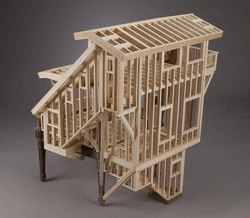
|
Lott’s first architectural-antique mash-up, Sit/Stay.
|
With Sit/Stay, Lott found his muse and went on to create ten more pieces that he christened the “Habitation Series.” Numbering them rather than naming them, Habitation #1 was made in 2012 from a pine table he found. It features grand Palladian windows and a roofwalk, or widow’s walk, with a balustrade.
|
Habitation #1, a found table, front and back.
|
In true collector fashion, Lott searches for pieces that inspire him.
“I go out to antique and thrift stores, yard sales and rummage sales. The piece with the rope ladder is an old piano stool with threaded wooden rods and a column of nice old walnut that I found at a thrift store. It was in such bad shape that they put it outside with a “Free” sign on it. I cleaned it up and put a finish on it. I stripped off the off old horse hair upholstery before transforming it.” It became Habitation #10.
|
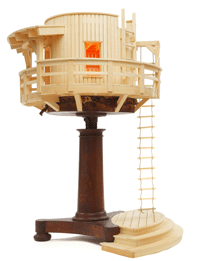
|
Lott found the piano stool base for Habitation #10 at a thrift store with a “Free” sign on it.
|
As his work is becoming known, he is acquiring found art in other ways.
“As I have progressed in the series, people have started giving me pieces of furniture. I had an exhibition at the University of South Carolina in Charlotte so I shipped some of my work there. When it was shipped back, an antique rocking chair was in with the pieces—not a Chippendale, but a nice chair.”
So how does the public feel about the work of Ted Lott?
“I am getting a lot of great response, really interesting press via the magic of the Internet. I have seen my work on a French design website and on a Chinese website. People love it. My favorite thing is for people to see my work in person—really sticking their faces up to it—and feeling them relate to it as a piece of furniture on that scale and as architecture on that scale.”
By day, Lott works as a designer for a firm that builds new homes and restores historical homes in Cooperstown, N.Y. He designs some furniture there, “…which I love because it ties into my studio work.”
While many in the Habitation Series feature new home designs (reflecting his other profession, for the moment), vintage styles and even Victorian architectural cues can be seen, as in the winding stairs of Keeper, which was made from a lamp with a four lights.
|
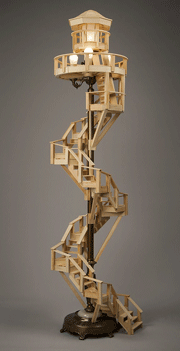
|
Keeper
|
Lott has happened upon more found art that has inspired him to create a second series, again with an artistic epiphany.
“I collect old luggage cases. Originally, I didn’t have a particular idea in mind…until I had a case sitting in front of me one day. It was an old wooden case with metal sides, and inside it were old roller skates. I was suddenly struck by the architecture of the case, so I created Migration #1 in 2014.”
|
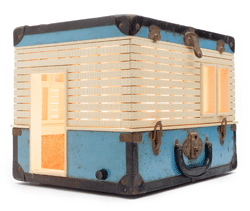
|
Migration #1
|
All nine pieces of the “Migration Series” are built-in “homes” of one sort or another, and all are illuminated inside.
|
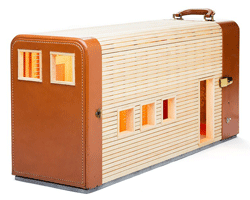
|
Migration #4
|
Lott has moved around often in his life. Born and raised on the shores of Lake Michigan, he has lived in twelve states and visited all states except Alaska. The thought of creating a moveable house that you can actually carry with you hit home with him, so to speak.
“I had an impulse to make smaller work. I had been making furniture-sized pieces, and as an artist, I move around a lot. When you make larger work, it is burdensome, especially to ship to exhibitions. With this, I am working in an interesting and fulfilling way and not spending three months on a single piece.”
Many of the old vintage cases are made of wood with leather or faux leather, which facilitated Lott’s construction. He doesn’t use glue. Instead, he employs a small pneumatic nailer, “…the same method as in building a house. The fact that the cases were made of wood makes it easy to nail right to them, which I love.”
Lott is working on more Migration pieces, but these will be created so they can be hung on walls. He also has more artwork to come. One series involves vintage books. With book covers that he loves, he cuts an aperture or window through the cover to a picture he likes in the book. Then, he frames out the window.
|
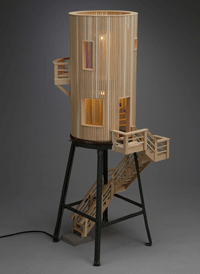
|
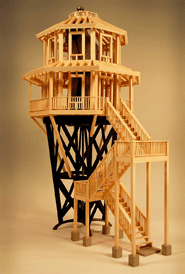
|
|
Habitation #4
|
Habitation #9
|
Lott is also planning a totally different series, one without wood and using ceramics, glass and other domestic objects.
“I am looking for objects that speak to those categories and how they fit in a domestic sphere by building architecture around them.”
While not as functional or as famous as the works of George Nakashima or Frank Lloyd Wright, Ted Lott’s view of architecture and his creativity and style follow in their footsteps—just on a smaller scale.
-----------------------------------------------
Ted Lott received his M.F.A. from the University of Wisconsin-Madison and his B.F.A. from the Maine College of Art. His work, encompassing sculpture, architecture, furniture, and public art, has been exhibited in museums and galleries across the country. He has been an Artist-in-Residence at the Anderson Ranch Arts Center, Kohler Arts/Industry Program, Haystack School, Vermont Studio Center, and elsewhere. His work and more information about him can be found at www.TedLott.com.
All photos courtesy of and © Ted Lott.
|